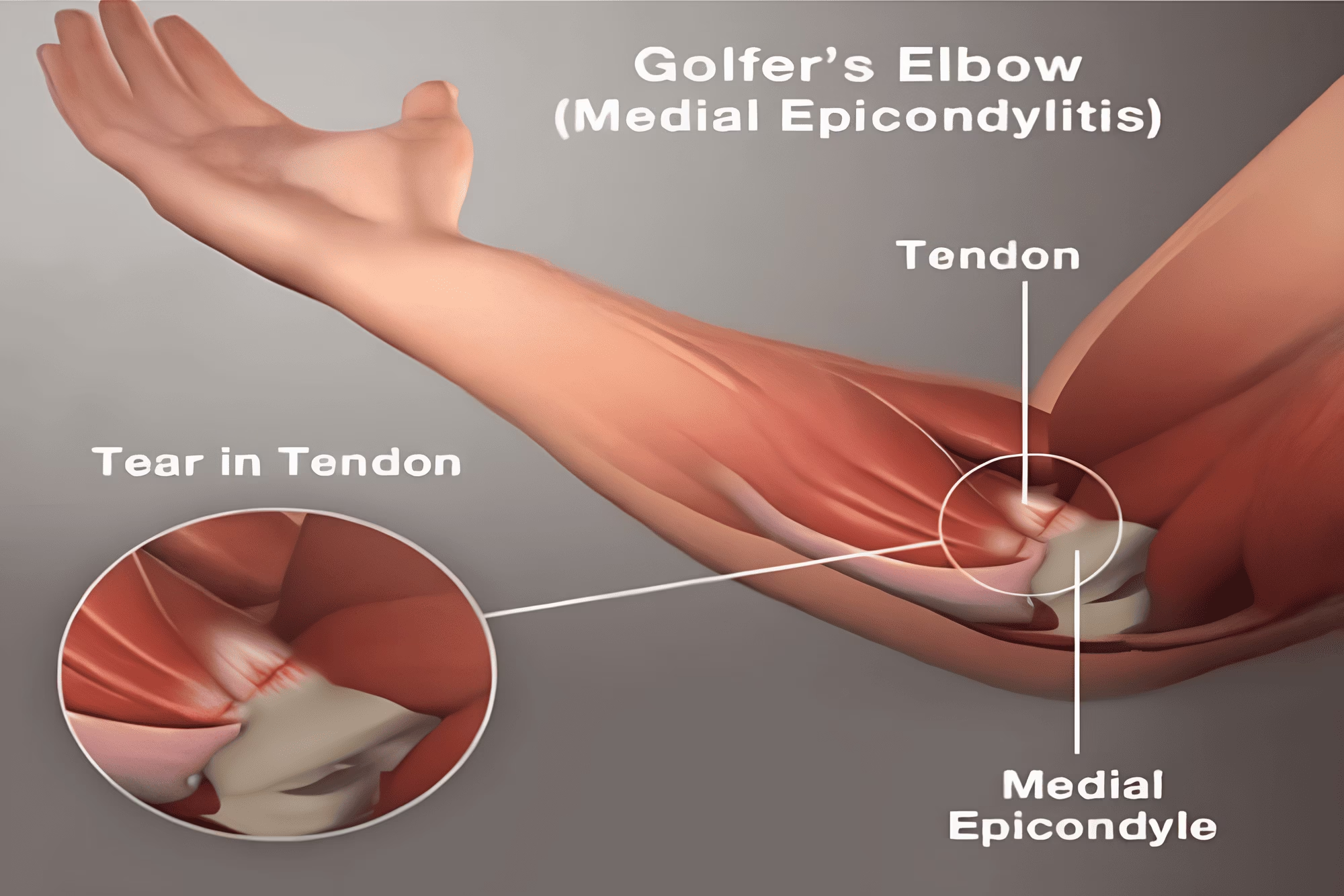Golfer’s Elbow (Medial Epicondylitis)
Golfer’s elbow is irritation of the flexor–pronator tendon where it attaches to the inner elbow (medial epicondyle). It causes pain with gripping, wrist flexion, and forearm rotation—common in golf, cricket, weight training, and desk work. This guide covers symptoms, causes, tests, treatment options, recovery, and prevention.
Written for patients in simple language. Evidence-based, exercise-first approach.

What is Golfer’s Elbow?
Also called medial epicondylitis, it’s a tendinopathy—a load-related tendon problem rather than simple inflammation. Repeated gripping, wrist flexion, and forearm rotation overload the tendon. Treatment builds tolerance with graded loading, corrects technique/ergonomics, and calms pain so you can use the arm confidently again.
Typical Symptoms
- Inner elbow pain, worse with gripping or lifting (kettlebells, dumbbells, bags)
- Tender spot over the bony inner elbow
- Morning stiffness; pain with wrist flexion or forearm pronation
- Weak grip, fatigue with typing or mouse use
- Pain with golf/cricket swing or resisted forearm drills
Common Causes & Risk Factors
- Training spikes (sudden increase in volume or intensity)
- Technique issues (early wrist break, casting, excessive grip pressure)
- Repetitive desk tasks with poor ergonomics
- Weak shoulder/scapular control leading to forearm overload
- Diabetes, thyroid issues, smoking (affect tendon health)
How we diagnose it
- Clinical exam: tenderness at medial epicondyle; pain with resisted wrist flexion/pronation; grip testing
- Ultrasound: shows tendon thickening or small tears; guides injections if planned
- MRI (selective): for persistent or unclear cases, or to rule out UCL/nerve issues

Treatment Options
Conservative (first line)
- Load management: reduce painful volume; avoid max gripping temporarily
- Exercise therapy: isometrics for pain → eccentrics/heavy–slow resistance (strap or dumbbells)
- Technique & ergonomics: grip size, swing sequence, mouse/keyboard setup, forearm rests
- Adjuncts: counterforce strap, short pain-med course if appropriate, topical therapies
- Timeline: many cases improve in 6–12 weeks with consistent loading program
Procedures (for stubborn cases)
- Ultrasound-guided injections: corticosteroid (short-term relief), PRP (biologic option) – discussed case by case
- Needle fenestration/tenotomy: stimulates tendon healing in chronic tendinopathy
Surgery (rare; last resort)
- Open/arthroscopic debridement & repair of the flexor–pronator origin
- Address associated issues (ulnar nerve symptoms or UCL pathology) when present
Related shoulder care: Shoulder Arthroscopy · Rotator Cuff Repair
Recovery timeline (typical)
Progress depends on symptom duration and training demands. This roadmap shows common milestones.
| Phase | What to expect |
|---|---|
| 0–2 weeks | Calm symptoms with isometrics, deloading, strap if advised; keep shoulder/scapula active. |
| 2–6 weeks | Introduce eccentrics and heavy–slow resistance; technique drills; gradual return to daily tasks. |
| 6–12 weeks | Build strength/endurance; sport-specific progressions; most daily activities comfortable. |
| 3–6 months | Return to full sport/work loads when strength and pain benchmarks are met. |
Prevention & return-to-play tips
- Warm-up forearm flexors; progressive loading (10–15% weekly increases)
- Neutral wrist at impact; adjust grip size and pressure
- Desk setup: elbows ~90°, forearm support, frequent micro-breaks
- Maintain shoulder/scapula and core strength to reduce forearm overload
Frequently asked questions
Is golfer’s elbow just inflammation?
It’s mostly a tendinopathy—changes in tendon structure and load tolerance—so progressive loading is key, not rest alone.
Do I need an injection?
Often no. Many improve with a structured exercise program. Injections (steroid or PRP) are options for stubborn cases after discussing pros/cons.
How soon can I lift weights or play?
Light work starts early if pain is controlled. Most return to full loads within 6–12 weeks, based on strength and symptom benchmarks.
Why does my hand tingle sometimes?
Occasional tingling may be from the ulnar nerve at the elbow. Persistent numbness needs assessment for Cubital Tunnel Syndrome.
Will it come back?
It can if workload spikes return. Keeping strength, technique, and workload progression sensible lowers the risk.
Bring any ultrasound/MRI reports. You’ll leave with a clear plan.


